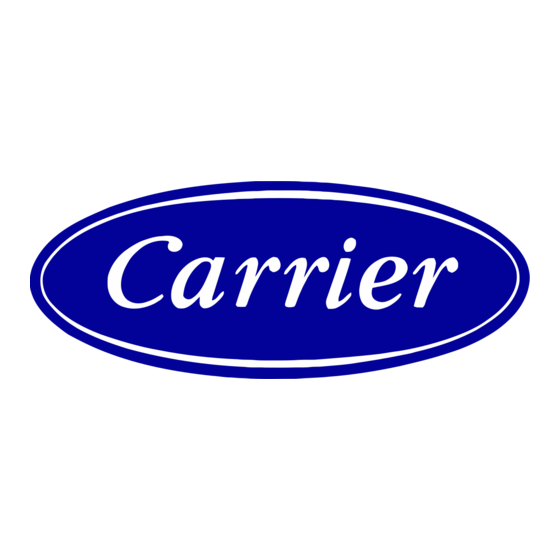
Table of Contents
Advertisement
Quick Links
KGACK0101HCK
NOTE: Read the entire instruction manual before starting the
installation.
SAFETY CONSIDERATIONS
Improper installation, adjustment, alteration, service, maintenance,
or use can cause explosion, fire, electrical shock, or other
conditions which may cause death, personal injury, or property
damage. Consult a qualified installer, service agency, or your
distributor or branch for information or assistance. The qualified
installer or agency must use factory- -authorized kits or accessories
when modifying this product. Refer to the individual instructions
packaged with the kits or accessories when installing.
Follow all safety codes. Wear safety glasses, protective clothing,
and work gloves. Have a fire extinguisher available. Read these
instructions
thoroughly and follow all warnings or cautions
include in literature and attached to the unit. Consult local building
codes, the current editions of the National Fuel Gas Code (NFGC)
NFPA 54/ANSI Z223.1 and the National Electrical Code (NEC)
NFPA 70.
In Canada, refer to the current editions of the National Standards of
Canada CAN/CSA- -B149.1 and .2 Natural Gas and Propane
Installation Codes, and Canadian Electrical Code CSA C22.1.
Recognize safety information. This is the safety- -alert symbol
When you see this symbol on the unit and in instructions or
manuals, be alert to the potential for personal injury.
Understand the signal words DANGER, WARNING, and
CAUTION. These words are used with the safety- -alert symbol.
DANGER identifies the most serious hazards which will result in
severe personal injury or death. WARNING signifies hazards
which could result in personal injury or death. CAUTION is used
to identify unsafe practices which may result in minor personal
injury or product and property damage. NOTE is used to highlight
suggestions which will result in enhanced installation, reliability, or
operation.
WARNING
!
FIRE, EXPLOSION, ELECTRICAL SHOCK
HAZARD
Failure to follow this warning could result in personal
injury, death and/or property damage.
The ability to properly perform maintenance on this
equipment requires certain knowledge, mechanical skills,
tools, and equipment. If you do not possess these, do not
attempt to perform any maintenance on this equipment
other than those procedures recommended in the User's
Manual.
Installation Instructions
HORIZONTAL INSTALLATION KIT
!
WARNING
FIRE, EXPLOSION, ELECTRICAL SHOCK AND
CARBON MONOXIDE POISONING HAZARD
Failure to follow instructions could result in personal injury,
death or property damage.
Improper installation, adjustment, alteration, service,
maintenance, or use can cause carbon monoxide poisoning,
explosion, fire, electrical shock, or other conditions, which
could result in personal injury or death. Consult your
distributor or branch for information or assistance. The
qualified
installer
factory- -authorized kits or accessories when servicing this
product.
WARNING
!
ELECTRICAL SHOCK HAZARD
Failure to follow this warning could result in personal
injury or death.
.
Before installing, modifying, or servicing system, main
electrical disconnect switch must be in the OFF position and
install a lockout tag. There may be more than one electrical
supply to the furnace. Check accessories and cooling unit
for additional electrical supplies that must be shut off during
furnace servicing. Lockout and tag switch with a suitable
warning label. Verify proper operation after servicing.
INTRODUCTION
In the Horizontal orientation, a field supplied accessory drain trap
grommet is required to seal the gap between the casing and the
condensate trap for Direct Vent applications. The condensate trap
outlet extends 2 inches (51 mm) below the furnace casing. To
allow for servicing the trap, the condensate drain tube in the loose
parts bag can be modified to make a coupler to allow for future
service of the condensate trap and drain line.
DESCRIPTION AND USAGE
The drain trap grommet seals the burner compartment of the
furnace to prevent ambient air from being drawn into the furnace
vestibule. It is only required for Horizontal installations when a
Direct Vent (2- -pipe) or Ventilated Combustion Air venting
application is used. It is not required for other orientations or when
a Non- -Direct Vent (1- -pipe) application is used. A Non- -Direct
Vent application is when the combustion air for the furnace comes
from the same location as the furnace.
1
or
agency
must
use
only
Advertisement
Table of Contents

Summary of Contents for Carrier KGACK0101HCK
- Page 1 HORIZONTAL INSTALLATION KIT KGACK0101HCK Installation Instructions NOTE: Read the entire instruction manual before starting the WARNING installation. SAFETY CONSIDERATIONS FIRE, EXPLOSION, ELECTRICAL SHOCK AND Improper installation, adjustment, alteration, service, maintenance, CARBON MONOXIDE POISONING HAZARD or use can cause explosion, fire, electrical shock, or other...
- Page 2 Table 1 – Kit Contents 6. Initiate component test through circuit board by referring DESCRIPTION QUANTITY to“Component Test” on status code label on blower access Horizontal Trap Grommet door for complete test sequence information. Installation Instructions 7. If any status codes are flashed, refer to status code label on unit blower door.
- Page 3 Cut and remove formed end of drain tube for left side and horizontal drain connection Remove knockout. Install grommet before relocating condensate trap. RIGHT SIDE DRAIN ELBOW A11348 A11343 Fig. 1 - - Remove Knockout / Install Grommet Fig. 2 - - Modify Drain Tube Attach tube to condensate trap Cut formed end off Field supplied 1/2”...
- Page 4 Catalog No:AG ---KGACK---01 Copyright 2011 CAC / BDP D 7310 W. Morris St. D Indianapolis, IN 46231 Printed in U.S.A. Edition Date: 09/11 Manufacturer reserves the right to change, at any time, specifications and designs without notice and without obligations. Replaces: NEW...


Need help?
Do you have a question about the KGACK0101HCK and is the answer not in the manual?
Questions and answers